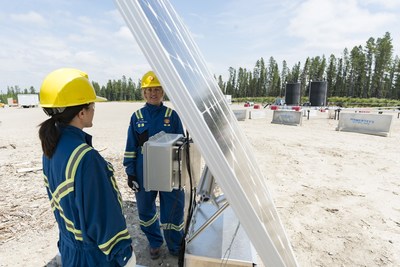
Shell launches methane detection pilot project in Alberta
by Cleantech Canada Staff

The technology, developed by Colorado's Quanta3, allows for constant monitoring of methane levels instead of Shell's current practice of using handheld cameras to detect the gas

The technology being tested in Alberta will allow for constant methane monitoring of natural gas wellsites. PHOTO: Shell Canada Ltd.
CALGARY—Shell Canada Ltd. has launched a new methane detection pilot program at one of its shale gas sites near Rocky Mountain House, Alta.
Shell has voluntary leak detection and repair programs across all its shale gas sites. However, the sensing system used in the pilot is a new technology that can continuously monitor methane emissions, unlike the handheld optical gas imaging cameras currently used which need to be manned by inspectors.
The technology was developed by Quanta3 LLC. of Longmont, Colo., and the system uses a diode laser to detect methane which does not require direct contact with the gas.
The company says its systems allow for 24/7 monitoring of natural gas infrastructure and are able to provide instantaneous updates, while determining the precise location and size of leaks.
According to Quanta3, the systems are also low-cost, low-maintenance and designed to withstand extreme weather and geological conditions. The sensing systems are solar powered as well.
Dirk Richter, founder and CEO of Quanta3, said: “Our technology provides operators with real time information on the integrity and performance of their sites.”
The pilot test for Quanta3’s methane detector is part of a wider initiative called the Methane Detectors Challenge.
The initiative, which aims to test the feasibility of new methane detection technologies, is being run in cooperation with the U.S. environmental advocacy group Environmental Defense Fund, other oil and gas companies, and several non-profit and university partners.
Earlier detection, more effective repair of methane leaks and reduced emissions are the goals of the initiative.
“A new frontier of methane detection is coming, and Shell is helping to give us a glimpse of that future. The ultimate test will be whether the industry scales new tools and approaches to minimize wasteful methane emissions in North America and across the world,” said Ben Ratner, director, Environmental Defense Fund.
West central Alberta was selected as the location for this pilot project as it offers the necessary infrastructure to adequately test the technology, and the frigid Alberta winters provide a unique testing environment.
“This pilot shows we’re serious about reducing the methane emissions associated with natural gas production to support the overall climate benefit of this fuel,” said Greg Guidry, executive vice-president, Unconventionals, Shell.
Guidry continued, “Shell is looking at all aspects of its operations, from equipment to processes, to assess and identify emission reduction opportunities.”
Shell’s Alberta pilot project follows a similar methane detection project initiated at a wellsite in Texas earlier this year.
The news of Shell experimenting with new methane detection technology comes several months after the Canadian government introduced plans for new, tougher restrictions on methane emissions.
The new restrictions, to be phased in between 2020 and 2023, will require energy companies to regularly check equipment for leaks, make repairs, use cleaner technologies, monitor emission levels and report results to Ottawa.
The goal is to reduce methane emissions by 40 per cent by 2025.
The feds estimates the regulations would cost industry $3.3 billion from 2018 to 2035, but says the costs of avoiding action on climate change would be more than four-times that.
Shell says methane is over 80 times more potent than C02 on a 20-year timespan and that it drives roughly 25 per cent of global warming.